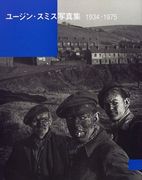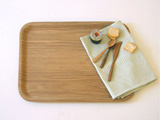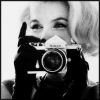サンフランシスコクロニクルに興味深い記事があるのでご紹介します。
敵対するパレスチナ、イスラエル双方のタクシーの運転手、教師、宗教指導者などの30フィートに及ぶポートレイトを対にし(みなおどけた顔でポーズをしていてます)、エルサレム、ベツレヘム、ラマラ、ヘブロン、アブディス、テルアビブ、ハイファの壁や建物、加えて因縁のイスラエルの防護壁にも張り出されているという記事です。
これはFace2Facehttp://
YouTubeにあるプロジェクトのトレイラーは下記。
http://
下記、記事の転載。
A troubled region shows its funny face
Giant portraits' goal to erode Israeli-Palestinian stereotypes
Matthew Kalman, Chronicle Foreign Service
Friday, March 16, 2007
http://
(03-16) 04:00 PDT Bethlehem, West Bank -- Palestinians and Israelis were confronted last week with a larger-than-life image -- of themselves.
Thirty-foot portraits of taxi drivers, teachers, religious leaders and others from each side of the conflict were pasted in pairs on walls and buildings around the country, including the controversial Israeli security barrier. They appeared in Jerusalem, Bethlehem, Ramallah, Hebron, Abu Dis, Tel Aviv and Haifa.
The photographs are part of a project titled "Face2Face," the work of self-styled French "artivists" JR and Marco -- they refuse to reveal their full names -- who first carried out a similar headline-grabbing project in Paris after riots there last year.
"I'm an artist-photographer who chooses the streets as the gallery," JR said as he climbed a ladder to paste the huge photographs on the exterior of a cement security wall surrounding an Israeli army base in Bethlehem. "Basically, I take pictures that I paste in the street, and I do this all around the world in different places, and the place where I put the photos is important for how the people will understand it."
"These people look the same; they speak almost the same language, like twin brothers raised in different families," he said. "We want that, at last, everyone laughs and thinks when he sees the portrait of the other and his own portrait."
Not everyone found it funny. The Face2Face duo was arrested March 3 by Israeli soldiers in Hebron, held for several hours and expelled from the town. A few days later, they were briefly detained by Israeli police in the old city of Jerusalem before being released with smiles and laughter all around and allowed to continue their project.
The photographs were purposely distorted in an effort to break through the stereotypes that each side has about the other.
"Palestinians and Israelis both suffer from the conflict, but although they are neighbors, they only see each other through the media. Both ignore the sufferings and the fears of the other," JR said.
"For an Israeli, a Palestinian is a terrorist who commits suicide attacks on a marketplace, killing women and children. For a Palestinian, an Israeli is an occupation soldier who humiliates him at the checkpoint and shoots civilians and ambulances. The reality is infinitely more complex," he said.
The photographs of 40 Israelis and Palestinians and one Christian priest were taken last summer using a 28mm wide-angle lens from very close up, and the subjects were asked to make funny faces expressing their feelings.
"I take a 28mm lens and I go 10 centimeters from you, so you have to know that something's going to happen with this picture," JR said.
Ayman Abu Alzulof, a Palestinian actor and tour guide from the West Bank town of Beit Sahour, near Bethlehem, said he agreed to be photographed because he knew the images would be seen on both sides of the border.
"It shows that both parties look like each other, as human beings, as races. It's difficult to differentiate between a Palestinian face and an Israeli face. It will also show that we live here," Alzulof said. "I think a lot of people will talk about it."
Marco, the other French artivist behind the project, said the two of them were trying to reflect a complexity not always obvious to people abroad. "Things are much more complex than what we thought, than what we were told by the media and by people on both sides before we arrived," Marco said.
"We saw people that within five minutes were in favor of war, in favor of peace, on both sides. It's very complex. People sometimes are good and bad at the same time. It's very ambivalent. That's something magic, and when you show them our pictures, sometimes we see Palestinians laughing when they see Israelis and vice versa, which is very funny, because they're not used to laughing when they see the others."
Not everyone in Bethlehem appreciated their efforts. Sheikh Taleb Awadallah, a local Muslim religious leader, said the huge distorted faces looked like the devil.
"This wall is evil," he said, pointing at the towering gray cement blocks of the Israeli security barrier. "But these pictures are more evil."
There are 19 double images -- a Palestinian and an Israeli -- in the collection. The single triptych is of three clerics: Rabbi Eliyahu McLean, Muslim Sheikh Abdul-Aziz Bukhari and Brother Jack Duncan, a Catholic.
"The Torah teaches that every human being is created in the image of God, so if everyone has different faces that they're given, those are also the faces of God," McLean said.
His words were reflected, like his photograph, by his Muslim opposite number.
"I see God's image in everyone," Bukhari said. "So if you see God's image in every person you look at, regardless what religion he has, when you love God and respect God, so you have to respect the person in front of you."
Marco said the setting was as important as the content. When JR was invited to exhibit a similar project in France at Paris City Hall, he agreed only on the condition that his images were displayed on huge billboards in Place Hotel de Ville, the square outside the building.
"I would qualify JR as an artivist, not an artist. It means that he uses all the ways that are available, including viral marketing (contagious publicity, through word of mouth, to generate buzz) and whatever, to show what he does," Marco said. "It's not activism, it's not art, it's something in between where you show your ideas and you display them the way people are open to see them. ... It's street art. It's second-generation street art. It's what comes after graffiti, the same family."
The artivists said they were not deterred by their brushes with Israeli security.
"In Hebron, it was a heavy situation, maybe more complicated than another city," JR said. "We came there to post really close to an army base, and they didn't know how to react. Also, maybe I shouldn't have posted on a door."
This article appeared on page A - 19 of the San Francisco Chronicle
敵対するパレスチナ、イスラエル双方のタクシーの運転手、教師、宗教指導者などの30フィートに及ぶポートレイトを対にし(みなおどけた顔でポーズをしていてます)、エルサレム、ベツレヘム、ラマラ、ヘブロン、アブディス、テルアビブ、ハイファの壁や建物、加えて因縁のイスラエルの防護壁にも張り出されているという記事です。
これはFace2Facehttp://
YouTubeにあるプロジェクトのトレイラーは下記。
http://
下記、記事の転載。
A troubled region shows its funny face
Giant portraits' goal to erode Israeli-Palestinian stereotypes
Matthew Kalman, Chronicle Foreign Service
Friday, March 16, 2007
http://
(03-16) 04:00 PDT Bethlehem, West Bank -- Palestinians and Israelis were confronted last week with a larger-than-life image -- of themselves.
Thirty-foot portraits of taxi drivers, teachers, religious leaders and others from each side of the conflict were pasted in pairs on walls and buildings around the country, including the controversial Israeli security barrier. They appeared in Jerusalem, Bethlehem, Ramallah, Hebron, Abu Dis, Tel Aviv and Haifa.
The photographs are part of a project titled "Face2Face," the work of self-styled French "artivists" JR and Marco -- they refuse to reveal their full names -- who first carried out a similar headline-grabbing project in Paris after riots there last year.
"I'm an artist-photographer who chooses the streets as the gallery," JR said as he climbed a ladder to paste the huge photographs on the exterior of a cement security wall surrounding an Israeli army base in Bethlehem. "Basically, I take pictures that I paste in the street, and I do this all around the world in different places, and the place where I put the photos is important for how the people will understand it."
"These people look the same; they speak almost the same language, like twin brothers raised in different families," he said. "We want that, at last, everyone laughs and thinks when he sees the portrait of the other and his own portrait."
Not everyone found it funny. The Face2Face duo was arrested March 3 by Israeli soldiers in Hebron, held for several hours and expelled from the town. A few days later, they were briefly detained by Israeli police in the old city of Jerusalem before being released with smiles and laughter all around and allowed to continue their project.
The photographs were purposely distorted in an effort to break through the stereotypes that each side has about the other.
"Palestinians and Israelis both suffer from the conflict, but although they are neighbors, they only see each other through the media. Both ignore the sufferings and the fears of the other," JR said.
"For an Israeli, a Palestinian is a terrorist who commits suicide attacks on a marketplace, killing women and children. For a Palestinian, an Israeli is an occupation soldier who humiliates him at the checkpoint and shoots civilians and ambulances. The reality is infinitely more complex," he said.
The photographs of 40 Israelis and Palestinians and one Christian priest were taken last summer using a 28mm wide-angle lens from very close up, and the subjects were asked to make funny faces expressing their feelings.
"I take a 28mm lens and I go 10 centimeters from you, so you have to know that something's going to happen with this picture," JR said.
Ayman Abu Alzulof, a Palestinian actor and tour guide from the West Bank town of Beit Sahour, near Bethlehem, said he agreed to be photographed because he knew the images would be seen on both sides of the border.
"It shows that both parties look like each other, as human beings, as races. It's difficult to differentiate between a Palestinian face and an Israeli face. It will also show that we live here," Alzulof said. "I think a lot of people will talk about it."
Marco, the other French artivist behind the project, said the two of them were trying to reflect a complexity not always obvious to people abroad. "Things are much more complex than what we thought, than what we were told by the media and by people on both sides before we arrived," Marco said.
"We saw people that within five minutes were in favor of war, in favor of peace, on both sides. It's very complex. People sometimes are good and bad at the same time. It's very ambivalent. That's something magic, and when you show them our pictures, sometimes we see Palestinians laughing when they see Israelis and vice versa, which is very funny, because they're not used to laughing when they see the others."
Not everyone in Bethlehem appreciated their efforts. Sheikh Taleb Awadallah, a local Muslim religious leader, said the huge distorted faces looked like the devil.
"This wall is evil," he said, pointing at the towering gray cement blocks of the Israeli security barrier. "But these pictures are more evil."
There are 19 double images -- a Palestinian and an Israeli -- in the collection. The single triptych is of three clerics: Rabbi Eliyahu McLean, Muslim Sheikh Abdul-Aziz Bukhari and Brother Jack Duncan, a Catholic.
"The Torah teaches that every human being is created in the image of God, so if everyone has different faces that they're given, those are also the faces of God," McLean said.
His words were reflected, like his photograph, by his Muslim opposite number.
"I see God's image in everyone," Bukhari said. "So if you see God's image in every person you look at, regardless what religion he has, when you love God and respect God, so you have to respect the person in front of you."
Marco said the setting was as important as the content. When JR was invited to exhibit a similar project in France at Paris City Hall, he agreed only on the condition that his images were displayed on huge billboards in Place Hotel de Ville, the square outside the building.
"I would qualify JR as an artivist, not an artist. It means that he uses all the ways that are available, including viral marketing (contagious publicity, through word of mouth, to generate buzz) and whatever, to show what he does," Marco said. "It's not activism, it's not art, it's something in between where you show your ideas and you display them the way people are open to see them. ... It's street art. It's second-generation street art. It's what comes after graffiti, the same family."
The artivists said they were not deterred by their brushes with Israeli security.
"In Hebron, it was a heavy situation, maybe more complicated than another city," JR said. "We came there to post really close to an army base, and they didn't know how to react. Also, maybe I shouldn't have posted on a door."
This article appeared on page A - 19 of the San Francisco Chronicle
|
|
|
|
|
|
|
|
報道写真/フォトジャーナリスト 更新情報
-
最新のアンケート
-
まだ何もありません
-
報道写真/フォトジャーナリストのメンバーはこんなコミュニティにも参加しています
人気コミュニティランキング
- 1位
- 暮らしを楽しむ
- 75478人
- 2位
- 大人のmixi【おとミク】
- 6433人
- 3位
- 写真を撮るのが好き
- 208284人
























